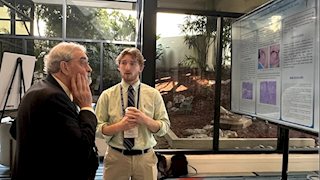Students studied T cells and skin cancer, maxilla and maxillary incisors and soft tissue

The top three 2024 studies have been announced in the West Virginia University School of Dentistry annual student research competition.
This year marked the 7th annual local AADOCR/DENTSPLY Student Competition for Advancing Dental Research and its Application (SCADA) and 56th annual School of Dentistry Alumni Research Competition.
Dental students complete a research project during the third year of the academic program. Working alone or in small teams, with a faculty mentor, students perform studies which examine a range of scientific issues, from caries and periodontal disease, to smoking cessation and oral health promotion.
First place: The role of T cells in HNSCC sex biases
Carson Cochran, Chance Shears, Harry Le, Trace Bennett.
PI: Dr. Franko; IACUC protocol: 2109045855
Evaluating myeloid-derived suppressor cell recruitment and function in males vs female HNSCC tumors CD8 lymphocytes
Summary
Our research was centered on the role of T cells in the sex bias of Head and Neck Squamous Cell Carcinomas (HNSCC). We worked with Dr. Jennifer Franko’s lab to evaluate the outcome of erasing the effects of T cells in male and female mice and cultivating HNSCC growth in these groups. We were able to observe that, just as with humans, normal males had a more profound growth of HNSCC compared to normal females, whereas mice who had their T cells effectively taken out of the equation no longer showed any bias in tumor growth between males and females. This shows us that the sex bias of tumor growth in males versus females is much more biological in nature, rather than just behavioral, as may have previously been assumed. We hope that this stepping-stone of research leads to better diagnosis and treatment outcomes for HNSCC patients in the future.
Second place: An Innovative Method for Measuring the Position of the Maxilla and Maxillary Incisors Relative to Soft Tissue Glabella in Adults and Adolescents: A Cephalometric Study
PI: Khaled Alsharif; IRB protocol: 2309849649
Noor Dahshan, Haider Jaffrey, Malik Bourghli, Dalal Ali.
Maxillary Position Relative to Glabella: A Cephalometric Study
Summary
Cephalometric analysis is a valuable diagnostic tool in orthodontic cases by allowing an evaluation of the relationship within and between the skeletal, dental, and soft tissue components. Our study aimed to use Soft Tissue Glabella(STG) from which a vertical plane was established to determine the sagittal position of the maxilla. This has been primarily determined relative to the cranial base structures by using SNAº (82 ± 2°). However, throughout the development of the craniofacial structures, S and N points slightly shift position as the SN plane develops. It is reasonable to assume that if the incisors are ideally positioned within the maxilla, per Andrews, then the ideal sagittal position of the maxilla can be determined relative to STG. Our results and data supported more reliability in Glabella Perpendicular than SNA.
Third place: Treatment Outcome Chart Review—Root Canal Therapy vs Extraction in Patients Aged 8-11 years.
Avery Smith, Joey Skonieczny, Rachel Rutledge, Caitlin Murphy.

